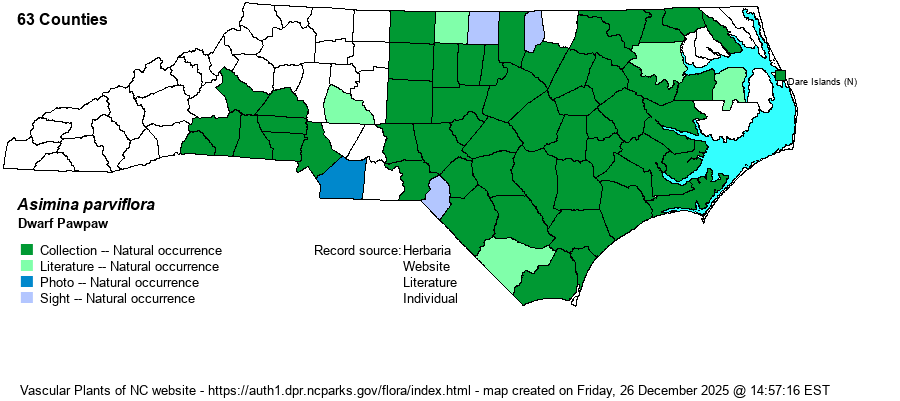| Author | (Michaux) Dunal | |
| Distribution | Occurs essentially throughout the Coastal Plain and much of the Piedmont, but apparently absent from the northwestern 20-25% of the Piedmont. Likely absent from a few far eastern counties in the Coastal Plain, especially those near Albemarle Sound. Not present in the Mountains. On the Outer Banks, known from Kitty Hawk Woods and Nags Head Woods, but not seen since 1976.
This is a Southern species limited to the Coastal Plains and Piedmont. It ranges north only to southeastern VA, south to southern FL and the Gulf of Mexico, and west to eastern TX. Though the range comes very close to TN, there appear to be no records for that state.
| |
| Abundance | Fairly common to common in most of the Coastal Plain and the eastern and southern Piedmont; not numerous in the central Piedmont, and rare close to the Mountains. It seldom occurs in colonies, but instead is more often found as scattered individuals (as compared with A. triloba). | |
| Habitat | This is a species of dry to mesic forests, mainly in oak or pine-oak stands. It may occur in somewhat rocky areas, but it also occurs in sandy soil, but not in xeric sandhills. Thus, it is a widespread species in choice of wooded upland habitats, but it is seldom seen in colonies or large numbers at any given site. It can be seen in drier parts of floodplain forests, though it is primarily an upland species. | |
| Phenology | Flowers in April and May, and fruits from July to September. However, mature fruits are infrequently seen. | |
| Identification | This is a fairly low deciduous shrub, growing mostly to 2-5 feet tall. The leaves are fairly distinctive, being rather large (often 3-5 inches long) for a small shrub; the widely obovate shape (much wider toward the tip than the base), typically with a blunt or rounded tip, is also helpful for identification. The leaves are rusty-haired below. It has somewhat unique flowers, which are dull yellow-green to dull purple and about 3/4-inch across; they appear on the naked twigs before the leaves emerge. Some plants can seemingly approach those of Common Pawpaw (A. triloba), which normally grows to a small tree, has noticeably larger and more purple-brown flowers, and leaves often much longer (sometimes close to 10 inches long). Despite its fairly wide range and at least moderate abundance, this shrub seems to be easily overlooked or under-appreciated by many biologists. | |
| Taxonomic Comments | None
| |
| Other Common Name(s) | Smallflower Pawpaw (or Small-flowered Pawpaw), Small-fruited Pawpaw. A few references spell the group name as Papaw. | |
| State Rank | S5 | |
| Global Rank | G5 | |
| State Status | | |
| US Status | | |
| USACE-agcp | FACU link |
| USACE-emp | UPL link |

